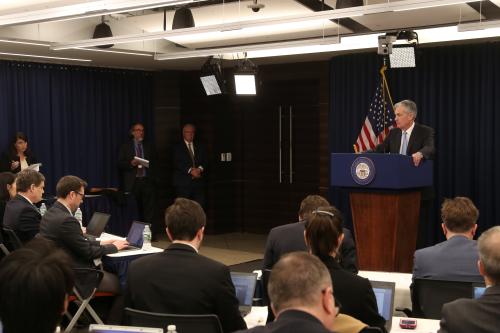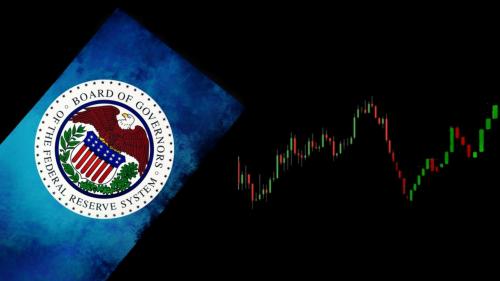The Federal Reserve is wrapping up a comprehensive review of its monetary policy framework that explored fundamental questions raised during the global financial crisis and its aftermath. Was the Fed’s strategy for pursuing its legal mandate of maximum employment and price stability the best one in a world where inflation—and consequently interest rates—remained stubbornly low even as the U.S. unemployment rate approached half-century lows? Were the tools deployed during the Great Recession the right ones to fight the next downturn? Could the Fed’s communications practices be improved? Brookings Institution scholars and conference participants have been thinking about these questions as well. See the compilation of selected research papers and articles below.
At his press conference in late July, Powell said that, as a result of the review, the Fed “in the near future” will revise its Statement on Longer-Run Goals and Monetary Policy Strategy. Board Vice Chair Richard C. Clarida, who is leading the review, said in an early August interview that the Fed is looking at “some important evolutions.”
The Fed’s policy committee, the Federal Open Market Committee, first adopted the strategy statement in January 2012 when Brookings Distinguished Fellow in Residence Ben S. Bernanke was Fed chair. Janet L. Yellen, who would succeed Bernanke as Fed chair and who also is a Brookings Distinguished Fellow in Residence, led the FOMC subcommittee that produced it. Though the Fed had informally judged two percent inflation as consistent with price stability since mid-1996, the 2012 statement formalized the target as two percent inflation as measured by the Commerce Department’s personal consumption expenditures price index. A 2016 amendment emphasized that two percent was a symmetric goal, meaning that policymakers “would be concerned if inflation were running persistently above or below this objective.”
Motivation for the Review
Except briefly during 2018, inflation has not sustainably reached two percent since the target was announced. An economic relationship known as the Phillips Curve suggests that low unemployment should lead to higher inflation. But historically low U.S. unemployment rates before the COVID-19 recession did not produce higher inflation. Economists aren’t entirely sure why.

Many consumers welcome very low inflation, but the problem is that very low inflation means interest rates, on average, remain very low. That, in turn, diminishes the Fed’s ability to fight recessions using its traditional tool—cutting its target for the interest rate on overnight loans between banks (the federal funds rate). The distance between the federal funds rate and its effective lower bound (roughly zero or a little less) has been shrinking. Fed policymakers’ median estimate of the neutral level of the federal funds rate—the rate at which monetary policy is neither expansionary nor contractionary—has fallen from 4.2 percent in January 2012 to 2.5 percent in June 2020.
Strategy
The Fed’s strategy for achieving its inflation objective has been what economists call a “bygones” strategy, meaning it does not try to make up for past misses. It simply seeks to move inflation back toward two percent—balancing its pursuit of price stability with achieving the other leg of its dual mandate, maximum employment. Economists at Brookings events have suggested that the Fed replace its bygones strategy with various “makeup” strategies. When inflation ran below target, for instance, the Fed could shoot for inflation temporarily a bit above two percent to make up for the undershoot while still aiming for two percent, on average, over a specified period.
Tools
When the federal funds rate is above the effective lower bound, the Fed can reduce it to support the economy during downturns. But, when the funds rate neared its effective lower bound during the 2007-2009 recession, the Fed began using two new tools—large-scale purchases of longer-maturity Treasury and government-backed mortgage securities (quantitative easing) and statements about its plans for short-term interest rates (forward guidance). Both tools were aimed at putting downward pressure on longer-term interest rates, such as mortgage rates and corporate bond rates. Other central banks have deployed tools that the Fed has not—such as pushing their short-term policy rates below zero (negative rates) or targeting rates on longer-maturity securities by committing to buy them at a predetermined price (yield-curve control).
The current review, conducted largely during a U.S. economic expansion of nearly 11 years, was focused on monetary policy during future downturns, which seemed comfortably distant. But the future arrived sooner than anticipated with the onset in February of the COVID-19 recession, and the Fed has resumed both large-scale securities purchases and forward guidance. The question is how these and other monetary policy tools might evolve as the economy struggles to recover from the current recession. At the start of the review, the Fed ruled out only two possibilities: changing its statutory maximum employment and price stability mandate and raising or lowering the two percent inflation objective. FOMC minutes subsequently have suggested that securities purchases and forward guidance would remain key parts of the Fed’s toolkit but that participants were skeptical about the usefulness of negative rates in the United States and weren’t ready to adopt yield curve control.
Communications
The third leg of the three-part review—communication—has received less public attention than the first two. But the Fed has long struggled with financial markets’ tendency to over-interpret the Summary of Economic Projections, which presents FOMC participants’ forecasts for inflation, unemployment, economic growth, and the path of the federal funds rate. Officials have stressed that the funds rate paths of participants are projections, not promises, and are subject to change in response to economic development.
As part of the review, the Fed conducted unprecedented public outreach that included a research conference in Chicago, 12 regional Fed Listens events (one at each Reserve Bank), and two events in Washington, D.C. The events included representatives of business and industry, small business owners and entrepreneurs, labor leaders, community and economic development officials, academics, representatives of retirees, nonprofit organization executives, community bankers, local government officials, and congressional aides.
Brookings Contributions to the Discussion
Brookings Institution scholars and conference participants in recent years have examined a wide range of issues relevant to the Fed’s review. Below is a sampling of articles and papers published as Brookings Papers on Economic Activity (BPEA) and by Brookings’ Hutchins Center on Fiscal and Monetary Policy:
The Fed should review its framework
Should the Fed regularly evaluate its monetary policy framework?
By Jeffrey Fuhrer, Giovanni Olivei, Eric Rosengren, and Geoffrey Tootell (Federal Reserve Bank of Boston)
Federal Reserve Bank of Boston President Eric Rosengren, in a Fall 2018 BPEA paper with three Bank economists, writes that U.S. monetary policy would benefit if the Fed at regular intervals conducted a formal and open review of its policy framework, with the aid of outside contributors.
Monetary policy with low interest rates and low inflation
The new tools of monetary policy
By Ben S. Bernanke (Brookings Institution)
In his January 2020 address to the American Economic Association, former Fed Chair Ben S. Bernanke warns that too-low inflation can threaten central banks’ ability to fight recessions. Too-low inflation is a problem because it contributes to low interest rates, which (because of the effective lower bound) reduce the scope for interest rate cuts. The new tools adopted by the Fed during the financial crisis—quantitative easing and forward guidance—were effective and should become permanent parts of central banks’ toolbox, he argues. To preserve the tools’ effectiveness, it is critically important for central banks to keep inflation and inflation expectations close to target, he concludes.
Monetary policy at the effective lower bound
By Kristin J. Forbes (MIT-Sloan School), James Hamilton (University of California, San Diego), Eric T. Swanson (University of California, Irvine), and Janet L. Yellen (Brookings Institution)
Former Fed Chair Janet L. Yellen, in a symposium with the authors of three papers presented at the Fall 2018 BPEA conference, discusses what monetary policymakers should do when interest rates approach the effective lower bound and what the lower bound could mean for their ability to set monetary policy. The papers examined whether monetary policy at the effective lower bound is less potent and generates increased international spillovers, and the extent to which large-scale securities purchases and forward guidance can substitute for traditional monetary policy.
Monetary policy in a low interest rate world
By Michael T. Kiley and John M. Roberts (Federal Reserve Board)
In a Spring 2017 BPEA paper, two Fed Board economists, using standard economic models, find that interest rates could hit zero as much as 40 percent of the time—twice as often as predicted in work by others. The constraint on monetary policy this would cause would make it harder for the Fed to achieve two percent inflation and maximum employment. The authors suggest that a monetary policy that tolerates inflation in good times near three percent may be necessary to bring inflation to two percent on average.
Rethinking the Fed’s 2 percent inflation target
By Lawrence H. Summers (Harvard University), David Wessel (Brookings Institution), and John David Murray (formerly deputy governor, Bank of Canada)
A Hutchins Center report in June 2018 explores alternatives to the Fed’s two percent inflation target. Summers recounts the origins of the two percent target and argues that targeting, instead, a rate of increase in nominal gross domestic product (GDP) would be better. Wessel analyzes three alternatives—raising the inflation target, targeting the level of prices rather than the inflation rate, and targeting nominal GDP. Murray explains why the Bank of Canada, one of the first central banks to adopt an inflation target, sticks with its two percent target.
What is “average inflation targeting”?
By David Wessel (Brookings Institution)
Wessel explains, in a May 2019 blog post, the motivations for the Fed’s review of monetary policy strategy, tools, and communications practices. He explores the advantages and disadvantages of average inflation targeting, an often-mentioned alternative to the Fed’s current framework. Under average inflation targeting, the Fed would aim to offset periods when inflation was below two percent with periods when it was above two percent, and vice versa.
Temporary price-level targeting: An alternative framework for monetary policy
By Ben S. Bernanke (Brookings Institution)
In a blog post, Bernanke explains his 2017 proposal for a new monetary policy framework for the Fed—temporary price-level targeting. Because the effective lower bound constrains monetary policy from being as supportive as it should be during and after recessions, the Fed would make up for periods of too-low inflation by committing to push inflation above target until it averaged two percent. An implication is that, to achieve the inflation overshoot, the Fed would keep interest rates lower for longer during periods of high unemployment and low inflation.
Monetary policy strategies for a low-rate environment
By Ben S. Bernanke (Brookings Institution), and Michael T. Kiley and John M. Roberts (Federal Reserve Board)
Bernanke, in a 2019 blog post, explains a paper co-written with Fed Board economists. It uses economic modeling to evaluate the effectiveness of Bernanke’s temporary price-level targeting framework along with other “lower-for-longer” strategies (promises by central banks during downturns to keep interest rates low even after the economy recovers). The paper finds that most of the lower-for-longer policies deliver better outcomes than traditional policy approaches in low-interest-rate environments.
The optimal inflation target and the natural rate of interest
By Philippe Andrade (Federal Reserve Bank of Boston), Jordi Galí (Center for Research in International Economics), and Hervé Le Bihan and Julien Matheron (Banque de France)
In a Fall 2019 BPEA article, the authors study how changes in the natural (neutral) interest rate affect the optimal inflation target. They find that starting from values before the financial crisis, a one percentage point decline in the natural rate should be accommodated by an increase in the optimal inflation target of about 0.9 to one percentage point.
Why are interest rates low?
The neutral rate of interest
By Michael Ng and David Wessel (Brookings Institution)
The authors explain the concept of the neutral rate of interest and why it matters in a Hutchins Center blog post in October 2018. The neutral rate is the short-term interest rate that would prevail when the economy is at full employment and stable inflation. Estimates of the neutral rate, both in the United States and in other economies, have been declining since the early 1970s, leaving the Federal Reserve and other central banks with less room to cut interest rates when necessary. They explore possible reasons for the decline in the neutral rate, including former Fed Chair Ben S. Bernanke’s global saving glut hypothesis and former Treasury Secretary Lawrence H. Summer’s secular stagnation hypothesis.
On falling neutral real rates, fiscal policy, and the risk of secular stagnation
By Lukasz Rachel (Bank of England) and Lawrence H. Summers (Harvard University)
In a Spring 2019 BPEA paper, the authors show, by using econometric procedures and looking at market indicators, that neutral real (inflation-adjusted) interest rates have declined by at least three percentage points over the past generation. Neutral rates would have declined by more than twice that if not for offsetting fiscal measures, they find. They argue that changes in savings and investment propensities explain the decline. They write that their findings support the idea that mature industrial economies are prone to secular stagnation. They conclude that, to achieve full employment and keep inflation from falling below target, fiscal policymakers will need to tolerate larger budget deficits and monetary policymakers will need to adopt unconventional monetary policies.
Safety, liquidity, and the natural rate of interest
By Marco Del Negro, Domenico Giannone, Marc P. Giannoni, and Andrea Tambalotti (Federal Reserve Bank of New York)
Four New York Fed economists write in a Spring 2017 BPEA paper that the decline of the natural (or, neutral) rate of interest is primarily due to strong demand for safe and liquid assets, especially U.S. Treasury securities, provoked in part by foreign and domestic crises over the past 20 years. They find that returns on securities that are less liquid and less safe than Treasuries, such as corporate bonds, have declined much less.
Why is inflation low?
What’s (not) up with inflation?
By Sage Belz. David Wessel, and Janet L. Yellen (Brookings Institution)
The authors in January 2020 Hutchins Center report explore reasons why the Phillips Curve has flattened (why inflation has become so unresponsive to job market pressures)—and why it matters. A flatter Phillips Curve means the Federal Reserve can err on the side of pushing unemployment lower without risking an unwelcome increase in inflation. On the other hand, lower inflation means interest rates are lower, leaving the Fed with less space to cut rates in response to a weak economy. And, a flatter Phillips Curve means the Fed might have to raise rates more than in the past if it became necessary to reduce inflation.
What’s up with the Phillips Curve?
By Marco Del Negro and Andrea Tambalotti (Federal Reserve Bank of New York), Michele Lenza (European Central Bank), and Giorgio E. Primiceri (Northwestern University)
In a Spring 2020 BPEA paper, the authors examine the origins of the disconnect between inflation and the ups and downs of the business cycle over the past 30 years. They conclude that, in response, central banks should adopt systematic monetary policy strategies, such as average inflation targeting, that react more forcefully to off-target inflation.
Inflation dynamics: Dead, dormant, or determined abroad?
By Kristin J. Forbes (MIT-Sloan School)
In a Fall 2019 BPEA paper, the author finds that, since the financial crisis, growing globalization has played an increased role in many countries in determining consumer price inflation. She argues that a better treatment of globalization in inflation models will help improve forecasts and could help explain the growing wedge between profits and the labor share of national income. Overall, however, she finds that while consumer price inflation is increasingly “determined abroad,” core inflation (inflation excluding food and energy) and wage inflation are still largely a domestic process.
The author did not receive financial support from any firm or person for this article or from any firm or person with a financial or political interest in this article. He is not currently an officer, director, or board member of any organization with a financial or political interest in this article. Prior to his consulting work for Brookings, he was employed by the Board of Governors of the Federal Reserve System.




Commentary
The Fed’s review of its monetary policy strategy—and what Brookings’ scholars have to say about it
August 12, 2020